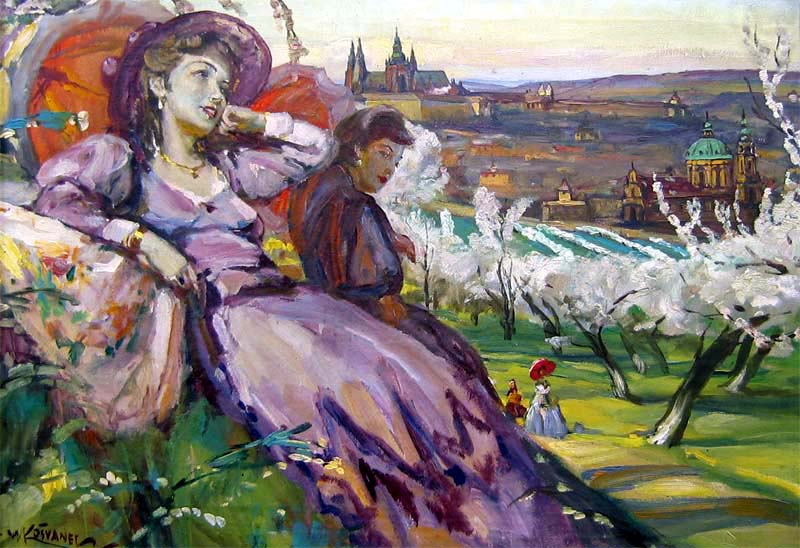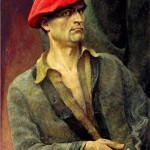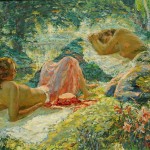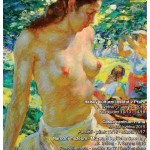One of the masters of twentieth century Czech art, who was long ostracized during the communist regime and recently rediscovered
A painter, cartoonist, illustrator and versatile creator, who explored impressionism, realism and symbolism, Vlastimil Košvanec was one of the most dynamic, talented and bright Czech artists of the twentieth century. This, at least, was the history of his youthful years and the best of his life: between the end of the Austro-Hungarian Empire and the first twenty-year period of the Czechoslovak nation. However, the period of his maturity and old age took a downward turn and he ended his life in anonymity, between the courthouses and the psychiatric clinics. Though he was still engaged in painting on canvas, he became a forgotten man, at least until his death in 1961, when Košvanec was 74 years old. A painful destiny, intertwined with the dramatic events that in those same years were to mark the history of the Country: from the Nazi invasion, during the Second World War, to Communist totalitarianisms that followed the conflict.
Vlastimil Košvanec was born in Prague, in the district of Karlín, on December 14, 1887 and was educated and formed in the capital city. He was the son of Bedřich Košvanec – a glover maker – and of Helena Košvancová, a seamstress. His artistic training began in the academy; at the “Fine Arts” in Prague he studied and worked with Professor Vojtěch Hynais, a master of Czech art of the Belle Époque, specialized in portraits and genre painting. With him, Košvanec started to experimenting drawing techniques, painting, portraiture and landscape. The influence of Hynais on the young artist was to be long lasting: lights, colors and personal aspects of his painting were passed on to the young Prague artist, profoundly influencing many of his future creations. During this formative period, Košvanec alternated his lessons of painting by travelling around Europe.
In a modern version of the Grand Tour of poets, or of the artists of the eighteenth or nineteenth century, the Czech artist visited a number of European countries. Journeys that were to continue even after the Great War, until 1939, and that took him to Italy, France, Austria, Germany, Holland and to the Balkan Peninsula.
 On completing his studies and a brief stint as a teacher at the Kolín Royal High School, Košvanec started his artistic career by working for a few magazines: he collaborated as a cartoonist for the Kopřivy magazine (a satirical publication of the Social Democratic Party between 1909 and 1931), and Sršatec (a satirical magazine published by the Communist Party in the nineteen-twenties). Anonymity, which for a political cartoonist means safety, was assured by the use of at least three nom de plume: V. Havrda, V. Patrik and Karambol. In the same period, Košvanec became popular also for the number of important illustrations made during the early nineteen-twenties: firstly, the ones he made for the book “Three men and a shark and other stories” by Jaroslav Hašek, author of the very famous novel “The adventures of the Good Soldier Švejk”, then for two of the four volumes of Victor Hugo’s monumental work, “Les Miserables”, published in Czech in 1923.
On completing his studies and a brief stint as a teacher at the Kolín Royal High School, Košvanec started his artistic career by working for a few magazines: he collaborated as a cartoonist for the Kopřivy magazine (a satirical publication of the Social Democratic Party between 1909 and 1931), and Sršatec (a satirical magazine published by the Communist Party in the nineteen-twenties). Anonymity, which for a political cartoonist means safety, was assured by the use of at least three nom de plume: V. Havrda, V. Patrik and Karambol. In the same period, Košvanec became popular also for the number of important illustrations made during the early nineteen-twenties: firstly, the ones he made for the book “Three men and a shark and other stories” by Jaroslav Hašek, author of the very famous novel “The adventures of the Good Soldier Švejk”, then for two of the four volumes of Victor Hugo’s monumental work, “Les Miserables”, published in Czech in 1923.
But it was in his painting, especially in portraiture, that Košvanec’s talent was recognized: it was the work on canvas that made him famous as a great artist during those years. The high society of Prague was quite keen to queue up, just to be immortalized in one of his portraits, that were particularly appreciated for their elegant and unique style. Aristocrats, businessmen, intellectuals, and even president Edvard Beneš were just a few of the guests at his Králosvky atelier.
Thanks to his versatile artistic genius, Košvanec was also able to explore other figurative horizons: taking inspiration from and revisiting French post-impressionism, the Czech artist created bucolic, mythical or allegorical scenarios. Light and use of color make his canvases overflow with lightness and joy of life. The women in his paintings are portrayed as nymphs inside flower gardens, his horizons are often inspired by the countryside or hills near the Czech capital. We are in the 1930s, the most creative period of his career. In those years, his artistic works were exhibited in Prague and in several other Czechoslovakian locations. His first solo exhibition, held in his birth city in 1939, was simply triumphant. For Košvanec, it marked the peak of his success, but also the beginning of his decline. Only a few years later, in fact, during the winter of 1941-42 – when the Country was occupied by the Nazi troops and Europe was at war – the artist donated his own fur-coat, during a collection to raise money, organized by German soldiers in one of the squares of the capital.
His gesture was quite farcical and provocative, but at the end of the conflict, it was considered sufficient to bring about an accusation of collaboration with the enemy and an expulsion from the Association of Czech artists. It was in 1947 when Košvanec was put on trial and sentenced to prison. Two years later, following the death of his wife, he fell into a deep state of depression and from his prison cell was sent to a psychiatric hospital. It was at that stage, when Košvanec was already in his sixties, that we lose trace of him. Thus, one of the most esteemed artists of the young Czechoslovakia was forgotten. In his biography, the facts are mixed with legend: from his sentimental relationship with a very young gypsy, to the last years of his life in total isolation, until his death in Prague, by then a poor and lonely man. And it is in the Czech capital, where he was born, that this irreverent cartoonist and painter of the joys of life and of flowered and undressed ladies, still rests today: in the cemetery of Olšany, among the great artists and writers.
by Edoardo Malvenuti







